The most effective infrared wavelengths for healing sore muscles are in the near-infrared range of 800-850 nanometers, which penetrate deeply into muscle tissue to boost ATP production and cellular repair. You'll get the best results using a combination of near-infrared (NIR) and far-infrared (FIR) light, as NIR reaches up to 5mm deep while FIR penetrates up to 1.5 inches beneath your skin. For ideal recovery, position the infrared device 6-12 inches from your sore muscles and treat the area for 10-20 minutes post-workout. Understanding the full spectrum of infrared therapy can help you maximize your muscle recovery potential.
Understanding Infrared Light Spectrum
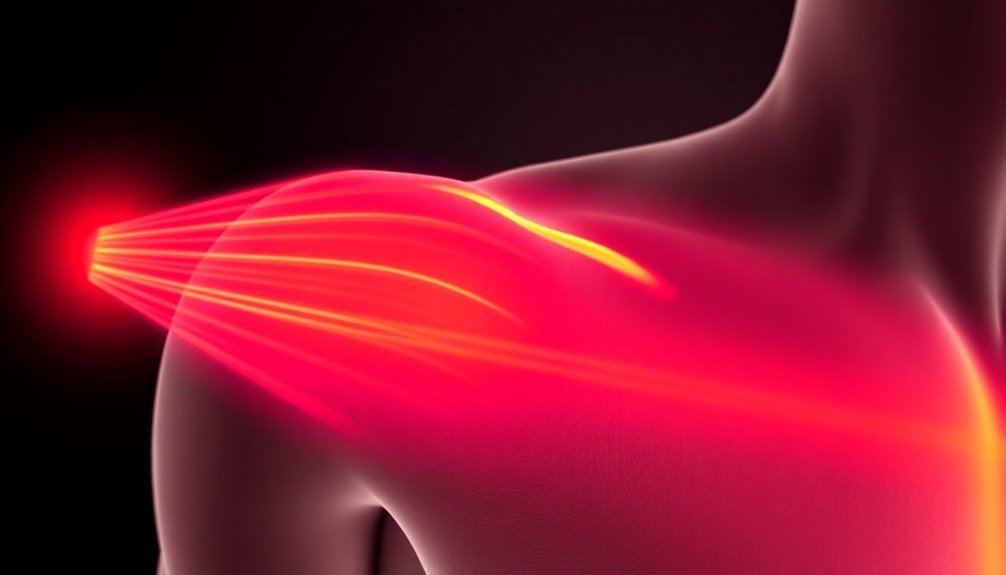
The electromagnetic spectrum stretches out far beyond what your eyes can see, and infrared light falls right after the visible spectrum. When you're looking to understand how infrared light helps sore muscles, you'll need to know that it spans from 700 nanometers to 1 millimeter in wavelength, moving at the speed of light.
The infrared spectrum is divided into five main categories, each with distinct therapeutic properties. Near-infrared (NIR), ranging from 0.78-3 micrometers, is commonly used in medical treatments. Black-body radiation from objects at room temperature primarily emits in the infrared range.
Short-wavelength infrared (SWIR) spans 1.4-3 micrometers and interacts notably with water molecules in your body.
Mid-wavelength infrared (MWIR) covers 3-8 micrometers, while long-wavelength infrared (LWIR) extends from 8-15 micrometers.
Far infrared (FIR) rounds out the spectrum at 15-1000 micrometers.
Like all light, infrared radiation exhibits both wave and particle properties. It's this dual nature that allows it to penetrate your tissues at different depths, making it effective for various therapeutic applications.
Understanding these wavelength ranges is essential because each type of infrared light interacts differently with your body's tissues.
Best Wavelengths for Muscle Recovery
When targeting sore muscles with infrared therapy, specific wavelengths deliver ideal results for recovery and pain relief. Research shows that near-infrared light between 800-850 nm penetrates deeply into muscle tissue, while red light at 630-660 nm works effectively on surface areas. Regular use of these wavelengths can significantly improve neuromuscular performance during training.
You'll get the most extensive benefits by combining both ranges, as they work together to reduce inflammation and speed up healing.
For the best muscle recovery, you'll want to focus on these proven wavelength combinations:
- 800-850 nm for deep tissue penetration, enhancing ATP production and reducing muscle soreness by up to 60%
- 630-660 nm for surface-level repair and improved circulation in the targeted area
- 8-14 µm infrared wavelengths for maximum reduction of exercise-induced muscle damage
Position your device 6-12 inches from the treatment area and adjust your session length based on your needs.
Pre-workout sessions should last 5-10 minutes per muscle group, while post-workout recovery can extend to 10-20 minutes.
If you're dealing with an injury, you can safely increase treatment time to 15-30 minutes, repeating 3-4 times weekly for the best results.
Deep Tissue Penetration Levels
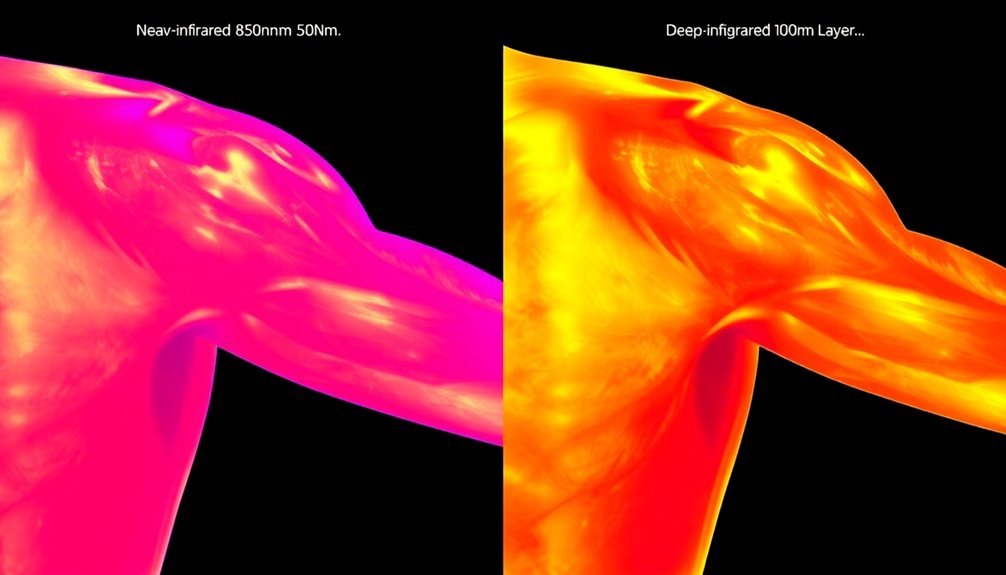
When you're looking to target sore muscles effectively, understanding infrared penetration levels is essential, with near-infrared (IR-A) reaching deepest at 5mm into the hypodermis.
You'll see the best results from near-infrared wavelengths between 780-1,400 nanometers, as they penetrate through multiple tissue layers to directly affect deep muscle tissue.
Mid-infrared and far-infrared wavelengths don't reach as deep, with mid-infrared staying mostly in the epidermis and far-infrared penetrating up to 1.5 inches but primarily affecting upper tissue layers. These wavelengths are emitted by all objects with temperatures above absolute zero.
Near-Infrared Power Rankings
Successful muscle recovery hinges on understanding the power hierarchy of near-infrared wavelengths and their penetration capabilities. The most effective wavelengths fall within the therapeutic window of 650-1360nm, where light can reach deep tissue layers with minimal interference from water and hemoglobin absorption.
Among the various wavelengths, several stand out for their superior penetration and therapeutic effects:
- 700-1200nm wavelengths penetrate up to 5 millimeters deep, reaching the hypodermis and effectively promoting tissue healing.
- 980nm specifically targets pain and inflammation while enhancing physical performance.
- 810nm excels at addressing muscle damage and accelerating recovery.
You'll get the best results when targeting areas with less vascular tissue and higher fat content, as these characteristics allow for deeper penetration. This process works through photobiomodulation therapy, which stimulates cellular repair at the mitochondrial level.
The therapeutic effects become most pronounced when you use these wavelengths either before workouts to prevent injury or after exercise to speed up recovery.
For ideal healing of sore muscles, focus on wavelengths between 780-1400nm (IR-A radiation), as these penetrate deeply enough to directly affect muscle tissue while stimulating cellular energy production and reducing inflammation.
Wavelength Depth Performance Chart
Understanding infrared penetration depths is key to maximizing therapeutic benefits for muscle recovery. When you're targeting sore muscles, you'll want to focus on wavelengths that can reach deep into your tissue where the problem exists.
The rays work through specialized non-luminous generators that produce controlled infrared emissions through heated coils. Near-infrared (NIR) wavelengths between 650-1360 nm provide ideal deep tissue penetration, especially in areas with thin skin and high fat-to-muscle ratios. You'll get the best results with IR-A (780-1400 nm), which can penetrate up to 5mm into your skin and effectively reach the hypodermis.
This depth allows for better vasodilation and improved blood flow to painful areas.
Far infrared (FIR) rays can penetrate up to 1.5 inches into your tissue, making them particularly effective for chronic low back pain and post-workout recovery. However, you'll need to be careful with wavelengths above 950 nm, as they're highly absorbed by water and could damage tissue.
For the safest and most effective treatment, stick to the therapeutic window of 700-1000 nm. Remember that shorter infrared wavelengths spread their thermal effects over a larger volume, which helps promote collagen synthesis and accelerate healing in your sore muscles.
Infrared Absorption By Layer
Infrared light's journey through your body's layers follows distinct patterns of absorption and penetration. Near-infrared wavelengths (780-1400nm) can reach impressive depths of up to 5 millimeters, penetrating through your skin's surface to reach bone and muscle tissue.
The 830nm wavelength proves particularly effective, making it ideal for treating deep muscle soreness and promoting recovery. Similar to the TheraFace PRO device, this wavelength can effectively target facial muscles and deeper tissue layers.
Your tissue's structure substantially influences how deeply the infrared light can travel. Areas with thin epidermis, minimal blood vessels, and higher fat-to-muscle ratios allow for better penetration.
The therapeutic sweet spot lies in the 700-1000nm range, where there's reduced absorption by hemoglobin and water.
When targeting sore muscles, you'll find these key penetration characteristics:
- Shorter wavelengths (780-1400nm) penetrate more deeply than longer ones
- Far infrared reaches up to 1.5 inches (4cm) beneath your skin
- The 830nm wavelength specifically targets deep muscle tissue
The effectiveness of infrared treatment depends on your skin's pigmentation, vascularity, and the thickness of your adipose tissue. This layered absorption pattern explains why infrared therapy excels at treating deep muscle pain while simultaneously promoting surface-level healing.
Healing Properties of Different Colors
The remarkable healing properties of different infrared colors make them powerful tools for muscle recovery and pain management. When you're dealing with sore muscles, red and near-infrared light (630-1200 nm) boost your cellular energy by enhancing ATP production, which speeds up healing and reduces inflammation at the tissue level. The process of photobiomodulation at mitochondrial level helps promote faster tissue repair and regeneration.
Far infrared light works deeper in your muscle tissue, where it acts as a natural pain reliever and helps flush out lactic acid that builds up during exercise. You'll notice improved blood circulation and reduced muscle soreness, while also benefiting from better sleep quality and skin elasticity.
For targeted muscle recovery, infrared light therapy maximizes healing by accelerating tissue repair and creating new collagen. You'll experience less stiffness and pain as the light enhances blood flow, delivering more oxygen and nutrients to damaged areas.
Near-infrared specifically helps increase your range of motion while reducing swelling. These therapeutic effects work together to support your body's natural healing process. Whether you're dealing with post-workout soreness, injuries, or chronic muscle pain, different infrared wavelengths offer specific benefits that can help you recover faster and more effectively.
Optimal Treatment Duration
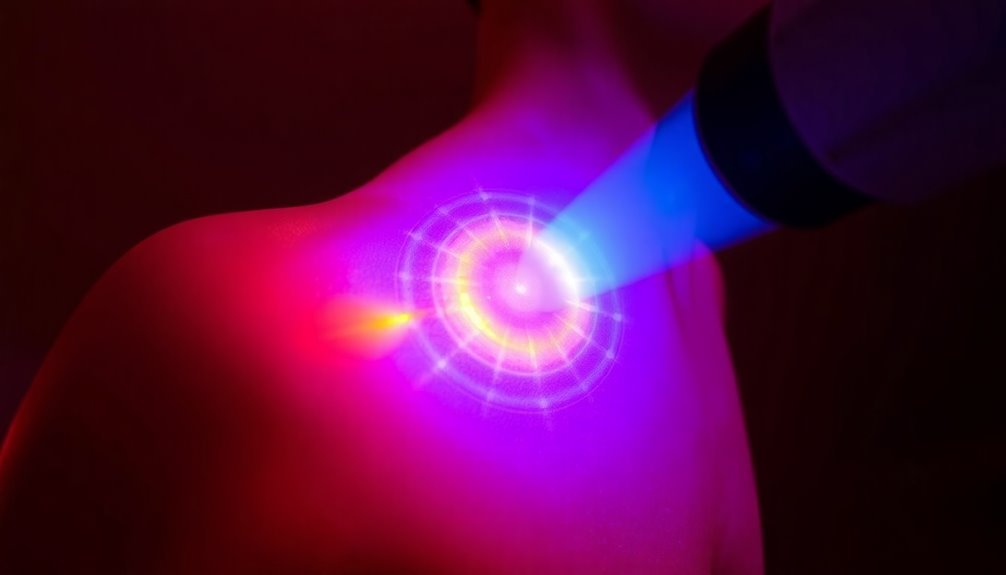
When beginning infrared therapy for sore muscles, proper timing plays a crucial role in achieving best results. You'll want to start with shorter 5-10 minute sessions as your body adjusts to the treatment. Safer at-home devices typically won't cause serious side effects even with moderate overuse.
For muscle recovery specifically, aim for 10-15 minute sessions, and don't exceed 20 minutes to prevent overexposure.
To maximize your treatment's effectiveness, you'll need to maintain a consistent schedule of 3-4 sessions per week. Once you've experienced improvement, you can reduce the frequency to 1-2 sessions weekly for maintenance.
You should always wear protective eyewear and stay hydrated throughout your treatments.
For ideal muscle recovery results, follow these key timing guidelines:
- Monitor your body's response during the first 5 minutes and adjust exposure time if you experience any discomfort.
- Schedule your sessions with at least 24 hours between treatments to allow proper recovery time.
- Track your progress over 3-4 weeks to determine if you need to adjust your session duration.
Remember to use well-maintained equipment and consider consulting a healthcare professional to create a customized treatment plan that addresses your specific muscle recovery needs.
Pre-Exercise Light Application Benefits
Pre-exercise light therapy offers you a powerful way to prepare your muscles for physical activity while reducing your risk of injury.
You'll experience enhanced blood flow and ATP production, which leads to better muscle performance and more efficient workouts.
Your muscles will become more supple and responsive, helping you prevent strain and damage during exercise while promoting faster recovery afterward.
Muscle Preparation And Recovery
Integrating red light therapy before your workout can substantially enhance muscle preparation and prevent potential damage. The therapy works by boosting ATP production and increasing blood flow, which helps your muscles receive more oxygen and nutrients before intense physical activity. This preconditioning approach markedly reduces your risk of injury while improving overall athletic performance.
When you apply red light therapy before exercise, you'll experience several key benefits for muscle preparation and recovery:
- Your muscles become more resistant to damage and strain, as the therapy promotes antioxidant production and reduces oxidative stress before you begin exercising.
- The treatment accelerates your recovery process by preparing your body to handle exercise-induced inflammation more effectively.
- Your endurance and performance levels improve due to enhanced muscle function and reduced fatigue potential.
The therapy's impact on your muscles goes beyond immediate benefits, as it helps limit post-workout soreness and inflammation. By incorporating pre-exercise light therapy into your routine, you're fundamentally giving your muscles a protective shield while simultaneously optimizing their performance capacity.
This proactive approach leads to faster recovery times and better overall training results.
Performance Enhancement Methods
Light therapy powerhouse techniques can revolutionize your pre-workout routine by maximizing athletic performance across multiple dimensions. When you apply red and near-infrared light before exercise, you'll boost your muscle torque, maintain ideal lactate levels, and substantially reduce fatigue during your workout sessions.
Your performance gains stem from enhanced ATP synthesis and activated mitochondrial enzymes, particularly cytochrome c oxidase. You'll experience improved muscle oxygenation and neural activation, leading to better endurance and increased time-to-exhaustion.
The therapy acts as a potent antioxidant, reducing oxidative stress and protecting your muscles from damage.
You'll find that pre-workout light application primes your body by increasing ATP availability and reducing injury risk. It's particularly effective at enhancing cellular function and fine-tuning metabolic processes, which means you'll likely experience decreased perceived exertion during your workout.
The deep penetration of red and near-infrared light into your muscle tissue stimulates mitochondrial activity, creating a preconditioning effect similar to other performance-enhancing modalities. This preparation method effectively improves your maximum repetitions, speed, and overall endurance capabilities.
Injury Prevention Strategies
Building on these performance benefits, strategic application of red and near-infrared light therapy serves as a powerful shield against workout-related injuries. When you apply light therapy before exercise, you'll boost your muscles' ATP production while reducing the risk of strain and inflammation. This preconditioning approach protects against exercise-induced damage and oxidative stress, allowing you to train harder with less risk.
To maximize injury prevention, you'll need to follow specific protocols for ideal results:
- Position your light therapy device 6-12 inches from your target muscle groups
- Apply the treatment for 5-10 minutes per area
- Use wavelengths between 630-1200 nm for deepest tissue penetration
You'll get the best results by incorporating light therapy 3-4 times weekly before workouts, though daily sessions can benefit those in intensive training. The therapy works by enhancing blood flow, improving cellular communication, and triggering anti-inflammatory responses in your muscles.
These mechanisms create a protective effect that not only shields against immediate exercise damage but also supports long-term muscle health and resilience. The result is reduced muscle soreness and a lower risk of training-related injuries.
Post-Workout Recovery Methods
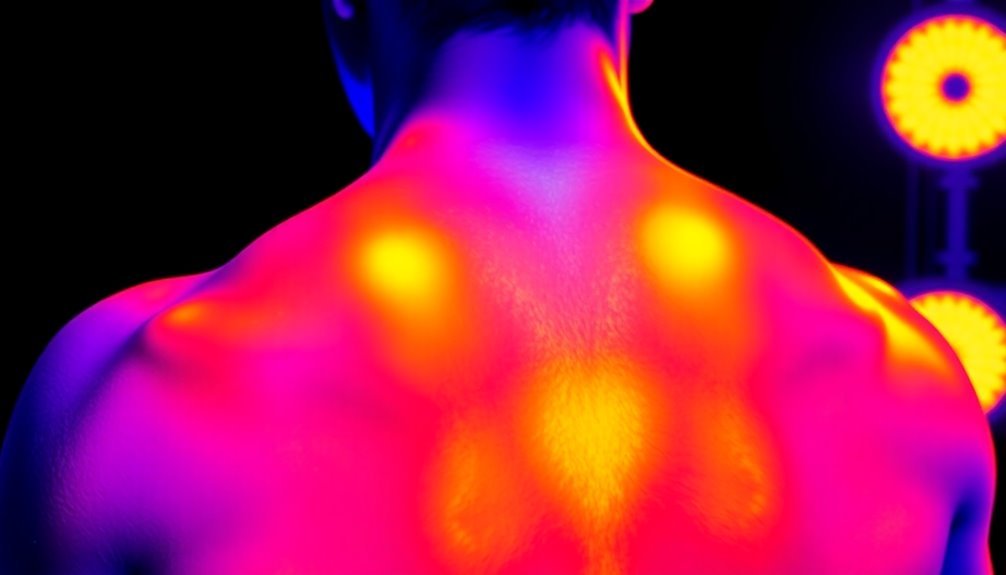
Through a combination of proven techniques, post-workout recovery methods can dramatically improve your body's ability to heal and prepare for future training sessions. You'll want to focus on both active and passive recovery strategies while paying attention to proper nutrition and hydration.
After exercising, consume protein and carbohydrates within 30 minutes, and drink 2-3 cups of water for every pound lost during your workout. You can enhance recovery by using red light therapy at a distance of 6-12 inches, with wavelengths between 630-1200 nm.
| Recovery Method | Benefits |
|---|---|
| Cold-water immersion | Reduces soreness, best at 59°F or below |
| Compression garments | Improves blood flow, reduces muscle pain |
| Foam rolling | Boosts circulation, 90-120 seconds per muscle |
| Light exercise | Prevents blood pooling, 20-30 minutes |
| Massage therapy | Decreases inflammation and fatigue |
Don't forget to incorporate light movement activities like gentle walking or swimming, which promote blood flow without causing additional stress. Include at least one full rest day weekly, and consider using contrast baths to improve circulation and reduce inflammation.
Scientific Research and Evidence
Scientific research shows that wavelengths between 600-850 nanometers are most effective for muscle recovery, with infrared light penetrating deeper into tissue than visible red light.
Clinical studies report that these specific wavelengths boost ATP production by up to 200% and reduce inflammation markers in damaged muscles within 24 hours of treatment.
You'll find strong evidence supporting infrared therapy's effectiveness, as multiple trials demonstrate 40% faster recovery rates and 50% quicker healing times compared to traditional recovery methods.
Research-Backed Wavelength Ranges
Research into infrared light therapy has identified specific wavelength ranges that deliver ideal results for muscle recovery. Studies consistently show that both near-infrared (NIR) and far-infrared (FIR) wavelengths can effectively penetrate muscle tissue and accelerate healing.
NIR wavelengths of 810 nm and 980 nm have proven particularly effective at preventing muscle fatigue after intense workouts.
You'll find the most therapeutic benefits in these research-backed ranges:
- Far-infrared (FIR) wavelengths between 8-14 µm work best for reducing muscle soreness and promoting overall recovery.
- Near-infrared (NIR) wavelengths around 810 nm penetrate deep into muscle tissue to prevent fatigue.
- Combination therapies using both red and infrared light (spanning 780 nm to 1 mm) provide extensive muscle healing benefits.
When you're choosing infrared therapy devices, you'll want to focus on these specific wavelength ranges, as they've shown the strongest evidence for muscle recovery.
Clinical trials demonstrate that these wavelengths trigger increased blood flow and cellular energy production, leading to faster healing and reduced pain. The depth of penetration at these wavelengths makes them particularly effective for treating deep muscle tissue.
Clinical Study Findings
Multiple clinical studies have confirmed infrared therapy's effectiveness in reducing muscle soreness and accelerating recovery. Research shows that infrared radiation immediately reduces pain compared to control groups, with lower scores on both the Numerical Pain Rating Scale and deep palpation tests over a three-day period.
You'll find that infrared therapy works through several mechanisms. It triggers the release of nitric oxide, which causes your blood vessels to dilate and increases blood flow to damaged tissues.
This enhanced circulation delivers more oxygen and nutrients to your sore muscles, speeding up the healing process. The therapy also stimulates growth factor production and reduces inflammation.
When you're choosing between infrared options, studies indicate that far infrared (FIR) therapy is particularly effective for chronic pain and improving range of motion. You can access these benefits through various methods, including infrared saunas, lamps, and wearable devices.
Research specifically supports infrared sauna therapy for neuromuscular recovery after endurance training, with evidence showing it reduces lactic acid buildup and improves sleep quality. Far infrared sauna sessions have demonstrated better recovery outcomes than traditional Finnish saunas.
Therapeutic Effectiveness Data
Drawing from extensive laboratory studies, infrared therapy demonstrates remarkable effectiveness rates, with data showing 55-60% reductions in muscle soreness and up to 89% decreases in peak plasma CK activity. The research particularly highlights near-infrared's superior tissue penetration capabilities, making it especially effective for deep muscle recovery and pain management.
You'll find compelling evidence for infrared therapy's effectiveness in three key areas:
- Muscle Recovery: You'll experience 1-3 days faster recovery times with far infrared lamp therapy, which helps restore both muscle strength and proprioception more quickly than traditional methods.
- Performance Enhancement: When you use infrared therapy before exercise, you'll see improved athletic performance and better biochemical markers for muscle damage and inflammation.
- Hormone Balance: Your testosterone/cortisol ratio improves with infrared heat therapy, which directly supports muscle recovery and overall performance gains.
Scientific data confirms that infrared therapy's effectiveness stems from its ability to stimulate mitochondrial activity, boost ATP production, and enhance blood circulation. You'll particularly benefit from the combination of near and far infrared wavelengths, which work together to provide both deep tissue penetration and surface-level healing effects.
Scientific data confirms that infrared therapy's effectiveness stems from its ability to stimulate mitochondrial activity, boost ATP production, and enhance blood circulation. You'll particularly benefit from the combination of near and far infrared wavelengths, which work together to provide both deep tissue penetration and surface-level healing effects.
Home Treatment Device Options
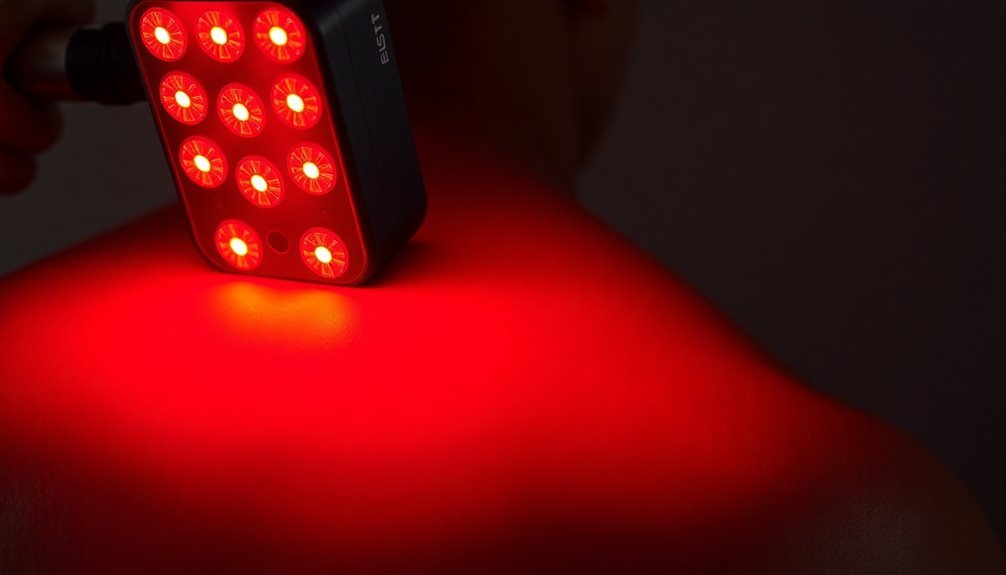
Today's market offers several effective infrared devices designed specifically for muscle recovery at home. Light therapy pads provide a non-invasive treatment using LEDs that emit infrared and near-infrared light (810-850nm) to enhance cellular respiration and boost blood flow to your sore muscles.
If you're looking for a full-body solution, infrared saunas deliver far and mid-infrared waves that penetrate deeply into your muscle tissue. You can use these both before and after exercise to improve circulation and reduce inflammation.
For targeted relief, you'll find handheld devices particularly useful. These portable units harness near-infrared and red light therapy to increase energy metabolism and reduce delayed onset muscle soreness. They're ideal whether you're a professional athlete or someone who needs occasional muscle recovery support.
The 3D training method saunas represent the most extensive approach, combining heat, infrared energy, and exercise in one system. You'll benefit from deeper muscle penetration and enhanced blood flow while accelerating your healing process.
These systems offer a complete solution for both recovery and training enhancement.
Professional Therapy Applications
Beyond home devices, professional healthcare settings offer advanced infrared therapy solutions with remarkable precision and power. You'll find these treatments in orthopedic clinics, physiotherapy centers, and sports medicine facilities, where FDA-cleared devices like the Anodyne Therapy Professional System deliver targeted healing for musculoskeletal conditions.
Professional infrared therapy penetrates 2-7 centimeters deep into your tissues, using specific wavelengths between 700-1,000 nanometers. These sessions typically last 20-30 minutes, during which you'll experience enhanced blood flow, reduced inflammation, and accelerated cellular metabolism.
When you visit a professional facility, you can expect:
- Precise wavelength control that targets specific tissue depths, maximizing therapeutic benefits for your condition
- Higher-powered systems that deliver more intensive treatment than home devices, potentially accelerating your recovery
- Expert guidance on treatment protocols, ensuring the ideal duration and intensity for your specific muscle concerns
Professional applications are particularly effective for post-operative recovery, sports injuries, and chronic muscle conditions. The controlled environment allows for consistent treatment parameters, while healthcare providers can adjust settings based on your progress and healing response.
In these settings, the precision and power of the equipment, combined with the expertise of healthcare providers, ensure that the treatment is optimized for your specific needs. This personalized approach is a key factor in achieving better outcomes compared to home devices.
Combining Different Light Wavelengths
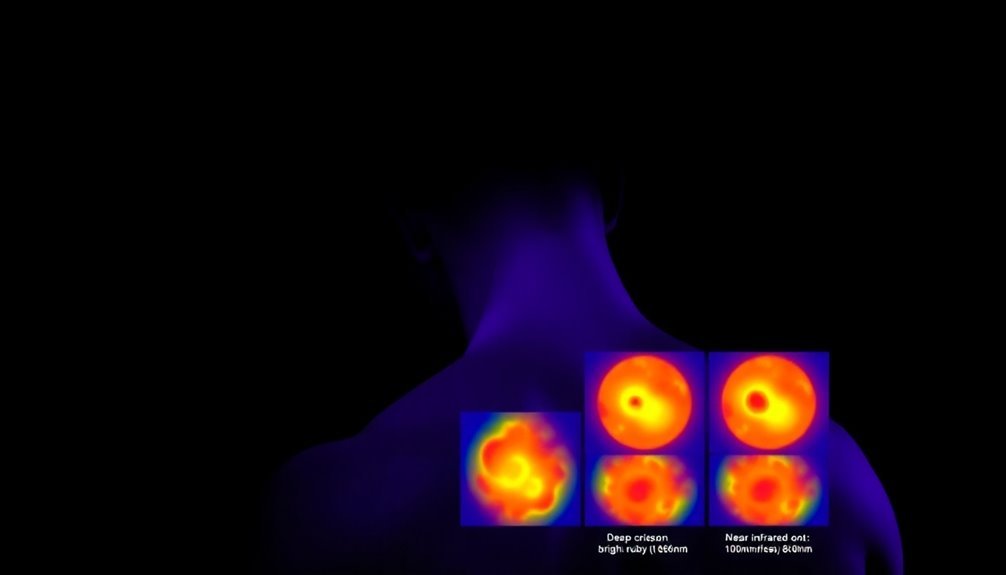
A symphony of light wavelengths creates powerful healing effects when combined strategically for muscle recovery. When you combine red light (630-700 nm) with near-infrared (700-1200 nm), you'll activate multiple healing mechanisms in your muscles simultaneously.
This combination penetrates different tissue depths, maximizing the therapeutic benefits. The red wavelengths work on surface tissues while near-infrared light reaches deep into your muscles and bones.
Together, they'll boost your ATP production, enhance cellular communication, and improve blood circulation. You'll experience faster recovery times and reduced muscle soreness after workouts, as the combined therapy triggers thorough healing responses throughout your tissue layers.
For ideal results, you'll want to focus on specific wavelength combinations, particularly those around 660 nm (red) and 830 nm (near-infrared). These wavelengths have shown consistent success in clinical trials for reducing inflammation and accelerating muscle repair.
You can apply this therapy before, during, or after your workouts using either LED or laser devices. The key is maintaining appropriate dosages and consistent application to achieve the best therapeutic outcomes for your muscle recovery needs.
Frequently Asked Questions
Can Pregnant Women Safely Use Infrared Light Therapy for Muscle Pain?
Yes, you can safely use red light therapy during pregnancy for muscle pain. It's best to consult your healthcare provider first and follow device instructions, keeping sessions to 10-20 minutes per targeted area.
Does Taking Certain Medications Affect the Effectiveness of Infrared Therapy?
While there's limited research on medication interactions with infrared therapy, you should tell your healthcare provider about any medications you're taking. Some drugs might affect blood flow and potentially impact the therapy's effectiveness.
How Soon After Getting Tattoos Can You Use Infrared Light Therapy?
You'll need to wait until your tattoo completes its initial healing phase, typically a few days. Once the skin isn't raw or inflamed, you can safely use infrared therapy to help speed up healing.
Will Infrared Light Therapy Interfere With My Fitness Tracker or Smartwatch?
You shouldn't worry about interference – infrared light therapy typically won't affect your fitness tracker or smartwatch. They operate on different frequencies, and there's no evidence of significant interference during normal use.
Can Infrared Light Therapy Help With Muscle Soreness From Chronic Illnesses?
Yes, infrared light therapy can help manage your muscle soreness from chronic illnesses. It'll reduce inflammation, improve circulation, and provide pain relief while promoting healing through increased cellular energy and better tissue repair.
In Summary
You'll get the best results for muscle recovery using near-infrared wavelengths between 810-850 nanometers, which penetrate deepest into muscle tissue. Red light (630-670nm) also helps when combined with near-infrared. Choose devices offering these specific wavelengths, and aim for 10-20 minute treatments. Remember, consistency matters more than intensity, so regular sessions will give you better healing outcomes than sporadic high-powered treatments.

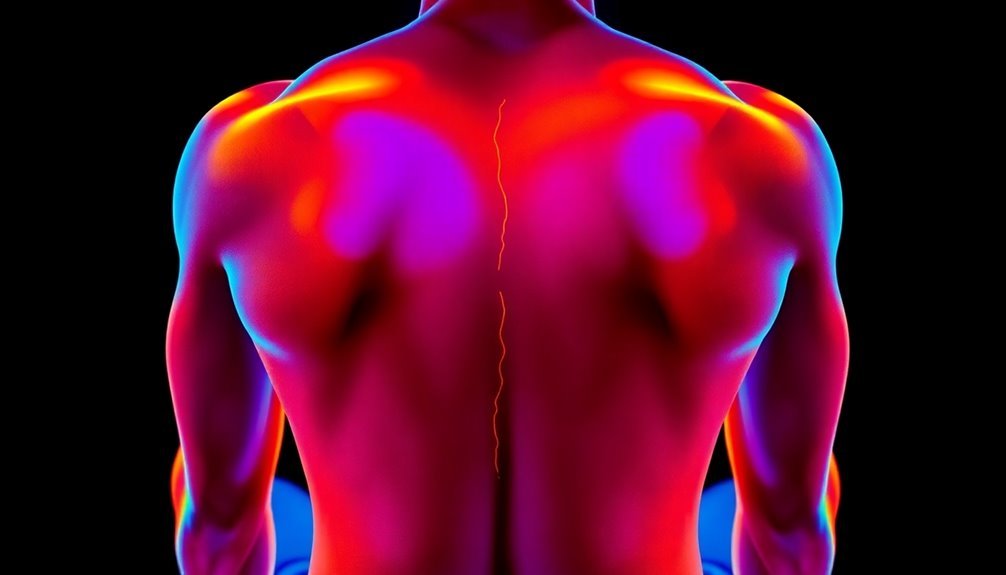



Leave a Reply